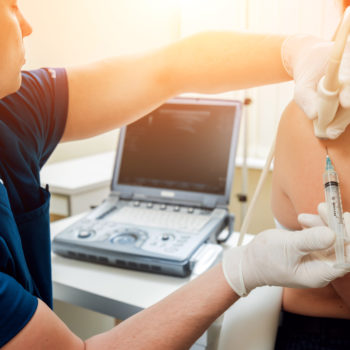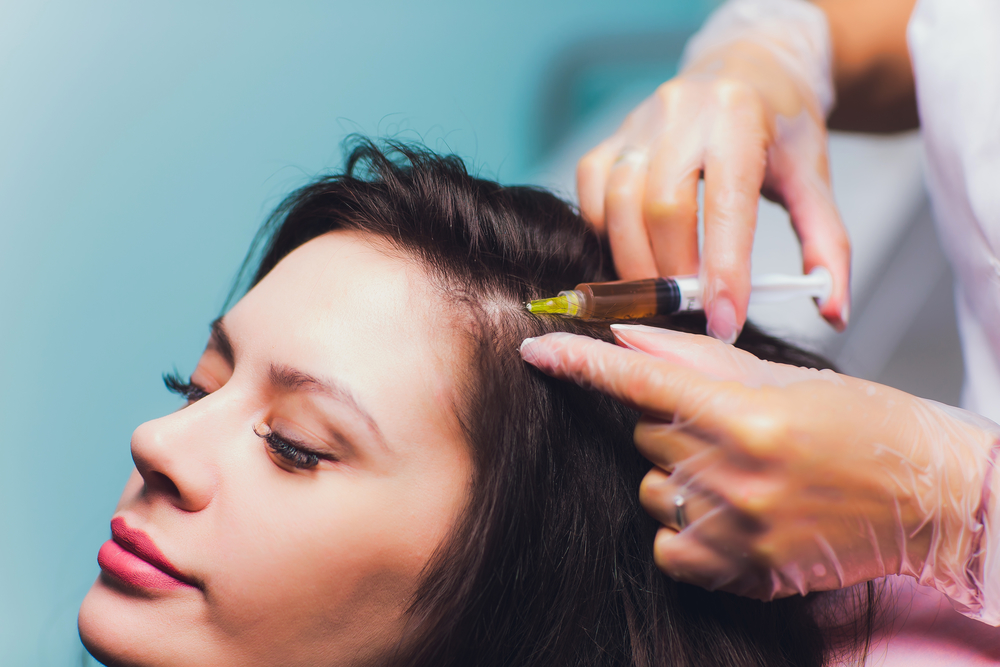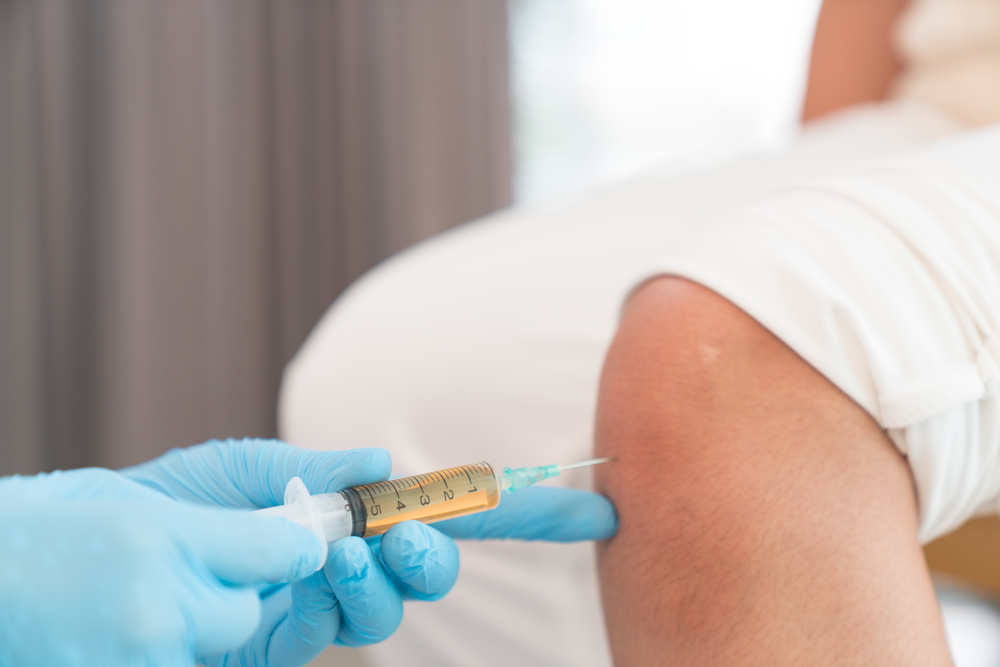Absolutely love this place! All the staff is excellent to work with. Explain everything you need to know, definitely helping to put me on the road to a long recovery!

 What is PRP?
What is PRP?The medical and scientific communities are excited and perhaps you’ve heard about a new medical procedure known as Platelet Rich Plasma (PRP) treatment.
Unlike most medical procedures that can involve medications and even surgery, PRP belongs in a class of medical treatments known as regenerative medicine, because PRP accelerates your body’s own healing process to treat a variety of conditions, some painful and some personal preference.
One key component of your blood cells is platelets. Blood platelets contain blood growth factors that are your body’s natural healing machines. With PRP, your own blood is concentrated so that the highest number of high platelet plasma is reintroduced back into your body and at exactly the place where it is needed.
You can read below how the PRP treatment process actually happens. But, first, let’s look at the ways in which PRP treatment can be used.
Perinatal tissue therapy, unlike PRP, uses cells that are typically not from our own body. They are safely produced in laboratories and then injected into the patient’s body.
Perinatal tissue is the building blocks of all living things. In humans, perinatal tissue develop specific “jobs,” such as heart cells, joint cells and bone cells. As we age, the number of cells that our body produces is reduced as a normal byproduct of aging.
Perinatal tissue treatment is used to reinvigorate growth and healing of chronic medical conditions.
With perinatal tissue treatment, the correct cells are used to promote and speed the healing and change process for a long list of medical conditions, including diabetic neuropathy, chronic pain due to bone or joint damage and even addiction.
You can read more about the differences in this Balcones Pain Consultants 2019 article.
PRP can be used for a variety of aesthetic and pain-relieving treatments. Here are some of the possibilities.
Hair Restoration

People who have lots of natural hair growth don’t understand the effect that significant hair loss can have on premature hair loss sufferers.
For many years, hair loss treatment was delivered by expensive and painful hair transplant surgery, as well as lotions, potions and even a dome helmet, known as the Theradome helmet that hair loss sufferers were supposed to wear that somehow stimulated new hair growth.
But, PRP is delivering great results, most noticeably for men and women who are suffering from:
Male or female pattern baldness- It’s normal for our hair growth to slow and our hairline to recede as we age. However, millions of people suffer from thinning hair and a receding hairline that’s much too early in life.
There are many causes of early pattern baldness. Family history certainly plays a role. But, there are other causes, including other medical problems, medications, diet and excessive alcohol and/or tobacco use.
Using poorly made and heavy shampoos, conditioners and other hair products will also impact hair growth and hair loss.
Even environment, including toxins in the air and too much sun exposure can impact our hair and hair loss.
Finally, high stress levels can impact hair growth, because levels of Elastin and Collagen production are reduced during periods of stress. If these stressful periods continue for too long, patchy or early baldness is often the result.
Medical conditions including alopecia areata, a disorder that causes patches of baldness on an otherwise healthy head are also treated with PRP.
Science and the medical community don’t know exactly what causes alopecia areata, but there are certain things that seem to increase the prevalence of the problem and they are much the same as with early male or female pattern baldness- medications, environment, diet, genetics and high stress levels.
PRP hair therapy works well because we use your own platelets to drive concentrated healing power to your scalp, spurring hair regrowth where you most want it. The platelets spur dormant hair follicles to again start producing new hair growth.
Typical PRP hair restoration treatment patients will start seeing results within a couple weeks of their first treatment with increasing results thereafter. The degree of and speed of results is largely determined by the extent of your hair loss and other factors that we’ll review with you at your free consultation.
Hair restoration does not need to be painful, weird or expensive. It also doesn’t need to use foreign substances or UFO helmets.
Face Treatments
The health of our skin and particularly the skin on our face is driven by elastin and collagen production. As we age, production of these two proteins naturally slows as a normal part of the aging process.
As a byproduct of aging, our skin also tends to be tighter and drier and this combination is where age lines, crow’s feet and other signs of aging come from.
In some cases, our patients want to tap PRP therapy for overall younger looking skin.
For others, PRP therapy is used to reduce or eliminate acne scars or uneven skin tones.
The most well-known PRP facial treatment is commonly known as the vampire facial where PRP treatment is combined with micro-needling to achieve younger and more tone-balanced skin on the face.
For acne scar treatment, dermal fillers may be used alongside PRP to smooth and contour your face.
It’s possible that you’ve already received low level laser therapy (LLLP) and seen moderate results, but want to take your scar removal to the next level. Although we are fans of LLLP, we are also aware of the limitations, just like with other skin surface layer treatments.
Unlike surface treatments, such as hyaluronic acid treatment, PRP works at a deeper skin layer, resulting in typically better and longer lasting results.
As an analogy, if you have a lawn and it doesn’t have the ability to retain moisture because the soil is hard-packed, you’ll likely have a brown and thin yard. You can spray water constantly with perhaps a small improvement in the color of the grass, but new grass growth will be almost nonexistent.
However, if you aerate your yard, opening the “pores” of the soil and also add seed and/or fertilizer with regular watering, you’ll have a healthy, thick and green lawn.
The health of your face, or your lawn, is largely driven by the depth of the care provided and PRP injections work on the deeper layers of your face while harnessing your own natural healing process to produce a healthy, glowing face.
The number of sessions you will need depends on several factors and we’ll review all of this with you at your 100% free consultation.
Joint, Tendon & Ligament Pain
 It’s frustrating when a joint injury impacts our ability to be active. It might be a simple ankle sprain or something more significant such as a torn interior anterior cruciate ligament in a knee or rotator cuff tear.
It’s frustrating when a joint injury impacts our ability to be active. It might be a simple ankle sprain or something more significant such as a torn interior anterior cruciate ligament in a knee or rotator cuff tear.
In some cases, the pain may be caused by accumulated injury over a long period of time, such as a repetitive motion injury often seen in tradesmen such as flooring installers.
Or, maybe you just got knocked around in your recreation soccer league, causing an acute, yet nagging injury that just doesn’t seem to want to go away.
Regardless of the injury, the growth factors concentrated in PRP therapy typically resolve the ongoing pain and inflammation associated with an injury.
Ligament, tendon and joint injuries, including those to the knee, elbow, shoulder, ankle, hip and back all respond very well to PRP treatment.
Sometimes, the joint pain and swelling will have nothing to do with an injury, but rather be caused by other ailments, including arthritis. PRP is a very effective treatment for arthritis.
In fact, the National Institutes of Health published this clinical update stating that PRP should be the first choice for osteoarthritis.
PRP treatment can also be used to resolve minor back pain, although perinatal tissue therapy will often be recommended for more significant spine and/or joint problems.
Using blood platelets injected near the site of the injury is similar to sending thousands of paramedics to the injury site, speeding the healing process while reducing local inflammation.
The alternative is often medications, including anti-inflammatories with a variety of side effects, steroid treatment and/or surgical intervention with long, slow recovery times and a much longer list of potential bad side effects.
Instead of struggling and suffering with chronic discomfort, our patients choose relief in a short series of PRP therapy sessions. During your free consultation, we’ll review your medical history and outline the number of therapy sessions needed to achieve the result that you are hoping for.
Chronic Plantar Fasciitis
Many people suffer through chronic plantar fasciitis and the debilitating foot pain that comes with it.
Unlike an acute case, chronic plantar fasciitis sufferers find themselves regularly trying to find relief with foot massage, ice rollers and other topical treatments. Or, they turn to more invasive treatments including steroid injections.
With PRP, healing happens from the inside out. Not only is the inflammation reduced, but the healing power of blood platelets helps to prevent future episodes as well.
Generally, the combination of PRP treatment and well-designed footwear and consistent foot care will eliminate chronic plantar fasciitis for good.
It typically takes more than one procedure session, but we’ll review this and answer any questions that you might have during your free consultation.
The PRP treatment process is very simple and straightforward.
We draw blood from your arm. Your blood is spun at high speed in a centrifuge.
By spinning your blood, we are able to separate the platelet rich plasma. The other two components, platelet poor plasma and red blood cells are discarded.
Once we have your platelet rich plasma, we inject it into the area of your body where it’s needed and wanted most. Each procedure will typically take less than an hour to complete and the healing process begins almost immediately.
Blood flow into the procedure area is increased by platelet activity, rapidly promoting healing and regeneration.
Different procedures take different amounts of procedures and differing numbers of injections. For example, hair restoration treatment might take more appointments versus therapy to correct uneven skin tone.
Because we are using your own platelets, there are very few side effects to PRP treatment and this is what sets regenerative medicine head and shoulders above conventional medical treatments.
It’s possible that you can have an allergic reaction at the injection sites, although this is incredibly rare.
In theory, although we maintain full sterile processes during your procedure, there is still a tiny possibility of an infection at the injection sites.
And, although we undergo extensive initial and ongoing training, it’s also possible that an injection may touch a nerve. For most procedures, however, we use a topical, local anesthetic, so you should be comfortable throughout your treatment process.
The time it takes to see results varies based on several factors.
First, different types of procedures have different expectations for seeing results. Hair follicles might start sprouting new hair growth in a week or two whereas a joint injury might take a bit longer.
Results also depend on the length of time between procedures. If you are available to follow our recommendation for how often to schedule each of your therapy sessions, you’ll see the fastest possible initial results.
Finally, the size and scope of the treatment area can affect results. There is a difference, obviously, if we are only treating a small balding area for hair restoration or skin tone versus extensive acne scar or a rotator cuff injury.
Each of us is different, but we will give you our best expectation of when you should start seeing results during your free consultation appointment.
When you attend your free initial consultation, we’ll review your entire medical history, medications, diet and exercise history, as well as any treatments you may have already tried.
Once we understand you, your history and your goals, we’ll be able to build a therapy plan, including number of needed treatments, frequency needed for the best results and the cost for your complete care. You won’t find little secret extra charges popping up, as the price we will quote you includes everything you need to be the version of you that you want to be.
Absolutely love this place! All the staff is excellent to work with. Explain everything you need to know, definitely helping to put me on the road to a long recovery!

